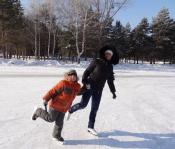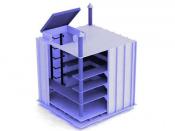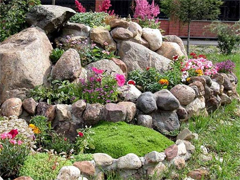Search
Login
Recommended
Creation of the Alpine hill
Currently, the desire to improve their summer cottages is becoming increasingly relevant, and this is understandable. Summer residents no longer need a lot of vegetables and fruits, they want to see their summer house beautiful and cozy - and first of all as a place of relaxation from the city bustle and unity with nature.
A place where each member of the family, regardless of his age, will find his own corner of interest and solve the eternal country question of the unwillingness of grandchildren to come to the cottage and work, work, work! The situation is almost revolutionary: grandchildren do not want to work in the country, and grandparents can no longer.
But what then is to be done with vacated vegetable beds and old barren fruit trees? What to do with a summer residence? There are many answers to this question, but we will not offer you extremes - to take and sell, no, you just need to jointly begin to re-plan and equip your summer cottage. Which way to go? You can try to learn how to create beauty in your own country or invite specialists in the field of landscape design, but ...
What they write about beautification in foreign literature and glossy metropolitan magazines is very beautiful, but somehow academic and not always clear to a simple summer resident. In landscape design, there are many tricks and elements that can radically change the appearance of the cottage and the plot. One of these elements is the alpine hill. Many summer residents themselves try to create such slides in the areas.
But if for the most part there are no problems with the construction process itself, then there are a lot of questions and mistakes with such moments as the location, shape, size and decorating plant material. There is still enough time until warm days to choose the shape and size of the future slide, think out its place in the garden, make rough calculations of the necessary material, and discuss your slide with family members.
There is no limit to your fantasies, but we’ll just show you how to avoid the most common mistakes in designing and building alpine slides. The slide should be readable, that is, fit into the natural landscape. It’s better to add a slide to the composition of the plot than to add something alien to it. It must be remembered that this is a composition of stones and plants, and not a random pile of stones, it imitates a mountainous landscape with ledges, grottoes and talus, and in the first place it should depend on the existing topography of the site.
By and large, there are two types of slides - on a natural slope and isolated, on a flat area. It is easier to build on a natural slope, it would be a slope, and on a flat plot it is more difficult to build: it needs a more complex reference to the surrounding landscape. When planning a rock garden, one must not forget that the slide imitates the natural exit of stones to the surface, therefore the shapes should be natural, and not regular, in the form of squares, rectangles or circles.
There should be no symmetry in the planned slide. Since terraces on the hill create tiers, it can be very difficult to avoid the temptation to build a symmetrical structure, in such cases either a holiday cake with symmetrical layers or a pyramid comes out. First of all, all the stones used must be decomposed so that they can be sorted by type, shape, volume and to find the dominant or key stones for laying in each tier or on the peak of the hill.
The shape of the stones should be different, the combination of chipped and round is unacceptable. It is advisable not to use granite and marble, since these stones are excessively decorative and artificial, are mainly materials of monuments and memorials and, from the point of view of strength, are eternal material. There are no cracks in granite and marble where plants could take root. - The stones are laid in tiers from bottom to top, but not the other way around. - First, large stones are laid, which fix the future contour of the hill and create the base of the lower terrace, and only then - small stones.
In this case, all large stones should rest on a drainage crushed stone base. - Stones, split into two parts, are good at creating narrow slotted holes for planting mountain plants with a deep root system. In this case, it is necessary to put a spacer stone in the gap and fill up the drainage. There should not be right angles between the lined stones. - There should be more stones on the south side than on the north. - Do not use concrete or other artificial joints.
Stones should be taken in quarries and preferably lay under the wind and rain. This will give the hill a natural and natural look. - The slopes should be gentle, but no more than 30 degrees, otherwise the slide will float and it will be dangerous to walk on it. It is advisable to stack the stones in groups, rather than in even horizontal rows.
Vegetable soil on top of the hill is at least 20–25 cm thick, as it is compacted by 30–40%. - After the slide is installed, it is necessary to carry out repeated watering - the soil will settle faster, weeds will climb to weed them before planting alpine plants. The golden rule: a slide should evoke positive emotions without vegetation, and even in winter!





